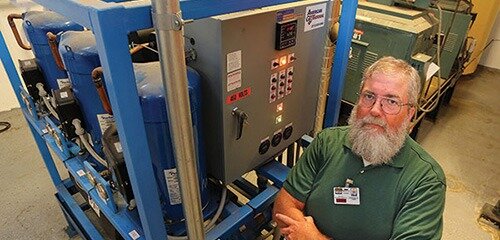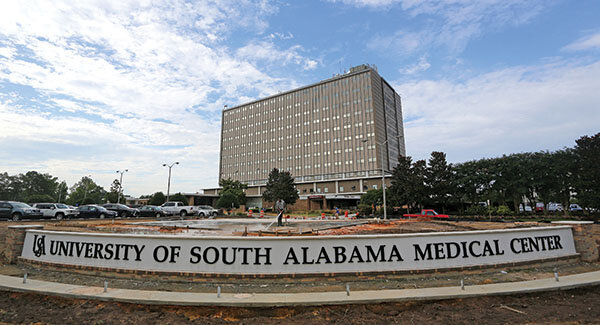Reliable Medical Center Facility Management
/Lawrence Gardner uses his artistic background to craft well-designed reliability and maintenance programs for the Univ. of South Alabama Medical Center—programs that also help prepare for unexpected disasters.
By Michelle Segrest, Navigate Content, Inc. — Reporting for Maintenance Technology Magazine


Each day, Lawrence Gardner looks at a blank canvas and finds new ways to paint a masterpiece. Whether it’s sketching a plan that creates more space for beds in a trauma center or designing effective preparedness plans for intense weather events that can attack the Southeastern Gulf Coast, Gardner finds a way to make the brush strokes blend together.
Gardner once had aspirations of becoming a civil engineer, but it didn’t take long into his first calculus class for him to decide to switch gears. He is artistic and loves to sketch, paint, and create silk-screen designs and ceramic sculptures, so his career pursuit took a dramatic turn.
He earned his Bachelor of Science and Master of Art Education degrees and became an art teacher. The career suited him, but earning enough money to support his wife and four sons became an impossible task. The solution was to combine his engineering goals with his artistic talent. Now, after 32 years as a reliability and maintenance professional at the Univ. of South Alabama (USA) Medical Center, Mobile, the director of facilities management flexes his artistic muscles in a different way.
“Every day I am designing, sketching, and drawing plans for different projects,” the 65-yr.-old said of his job with the center. “We do many renovations in an organization like this. We are constantly creating plans to send to a draftsman, who then creates a CAD file for contractors or for our own staff to use. I use my art degree every day.”
While the career path was different than most reliability and maintenance professionals, it has helped Gardner be diverse and creative in his primary responsibility of daily problem solving for the facilities that make up the 525,000-sq.-ft. campus.
“I feel like every step in my career path has been directed at getting me to a level of competencies and skill sets that are perfect for this job that I have today,” Gardner said. “Facilities management is not that far a cry from being an artist or an art teacher. It depends on what part of your mind you need to use. When it comes to managing people, I use different types of motivation to push people to the maximum of their competencies. It’s important to me that every person on my staff has the opportunity to excel to their greatest potential.”
Life and Death Facility Management at Medical Center
The USA Medical Center is a Level 1 trauma center for the southwest-Alabama region, in particular the Mobile Bay area and southern Mississippi. The next closest Level 1 trauma center is the Univ. of Alabama-Birmingham, located nearly 300 miles north. The USA facility is also the regional burn-treatment center, including occupational and physical therapy.
The medical center was originally built in the 1960s as a county general hospital. The university purchased it from Mobile County around 1975. The goal was for the hospital to integrate its medical school students and have attending physicians who would double as associate professors in the College of Medicine. The campus also includes a facility formerly known as Providence Hospital. It covers another 500,000 sq. ft. of physician offices and clinics.
Gardner is responsible for anything that has to do with the physical plant, including renovations, new construction, modernization, and all equipment maintenance. This involves everything from elevator maintenance to heating and air-conditioning systems, electrical systems, generators, and medical equipment.
“If it’s part of the building, it belongs to our department,” Gardner said. “From the roofs all the way down to the basements, we maintain anything and everything.”
Gardner’s team at the main campus includes 18 full-time employees (technicians, electricians, plumbers), six of whom are supervisors. Subcontractors are also occasionally used. In addition to this role, which he has held for seven years, he has worked at three different hospital systems in his 32-year career.
The medical center has a 130-bed capacity. During a trauma event, the facility may treat as many as 150 patients. There are about 1,200 medical professionals in the system and another 600 who work at the clinics and with the physicians.
Facility Maintenance Prioritization and Problem Solving
For Gardner’s maintenance team, challenges come in the form of medical-trauma emergencies and all that results from maintaining buildings that are almost six decades old.
“First and foremost, we are problem solvers,” he said. “We are a customer-service-driven organization. We are here for everyone from the nurse managers to the IT guys to the kitchen dietary folks. We may get a call from the operating room saying the light over the operating table is out of balance. Or perhaps a floor drain is stopped up in the kitchen or a radiologist is having difficulty with his equipment. With such an old facility, we are dealing with systems that are a living, breathing organism. We are challenged with a huge variety of needs from 1,800 people.”
For prioritization, Gardner uses a systematic approach that is part of routine maintenance.
“We have a supervisor who is charged with analyzing the requests that come in through our preventive-maintenance program or our maintenance-request program,” he explained. “He issues the work orders to the different mechanics. If it is something above or beyond the requests that would normally be handled by that group, they run it up the flagpole to another level of supervision to analyze if it is something we can do internally. If it’s something we need to review as far as a project that needs an outside contractor or is a project that is beyond our maintenance staff’s capabilities, it is reviewed as a future capital project. This requires submitting an estimate that goes to an administrator and then goes through a formal financial-review process to be approved so it can be budgeted.”
When patients’ lives are at stake, it puts added pressure on the maintenance team to keep all operations running smoothly.
“Our responsibility is maintaining a continuity of operations 24 hours a day, seven days a week, 365 days a year,” Gardner stated. “We have patients who are hooked up to life-saving devices. Some of the operating rooms must maintain a specific temperature. There is a level of air quality needed, so we must carefully maintain the filters throughout all systems. We are dealing with buildings built 55 years ago. The design at the time may have been just right, but with new codes and regulations, we must make adjustments and deal with ongoing problems all the time. We must find solutions, while providing excellent service in a building that is showing its age.”
Gardner implements a priority rating system. It includes bullet points that ask key questions such as:
Is this a safety issue?
Who is at risk?
Is this a regulatory requirement?
There is a point scale and projects are ranked according to urgency and impact on the organization. Gardner’s team handles between 7,000 and 8,000 work-order requests each year.
“We have preventive-maintenance programs where we have established protocols, processes, and procedures based on either manufacturer’s recommendations or our own risk analysis on particular pieces of equipment, utilities, or devices,” Gardner stated. “We rank based on the potential timing needs. For instance, filtration of air in operating rooms has high priority. Those filters get clogged with all these dust particles and microns of dirt and can cut down the supply of air going into the room and contaminate the air. If the manufacturer says normally you can change these every year we might change ours every nine months so this goes into our preventive-maintenance scheduling.”
Sometimes special circumstances require creative outside-the-box thinking. “For example, we needed to replace an air-conditioning unit, but shutting down an intensive-care unit in a trauma hospital is not an option,” Gardner said. “The unit was 15 feet wide, 55 feet long, and 10 feet tall, and you just can’t disassemble it and put another one in its place the same day. So, we came up with a solution where we added another unit on the roof adjacent to the old one, ran all the chilled-water piping, hot-water piping, electrical, wiring, duct work, etc., and tied it all together to the power and new breaker panel. We did this in about a six-hour period and made sure it happened on a cool winter night. The old unit is still sitting there because it doesn’t make sense to move it.”
“These are the type of things you have to do in a healthcare organization to be able to provide that continuity of services so that customer service in the environment of care is not compromised and nobody knows that we are even here.”
Disaster Preparedness in Facility Management
Hurricanes and tropical storms are common on Alabama’s Gulf Coast. Most emergency generators are powered by diesel engines, Gardner said. The diesel fuel is provided by a service vendor who also occasionally fills the tank. When a hurricane is approaching, one of the first things that is checked is the fuel level, and trauma centers generally get priority.
The team had learned lessons from Hurricane Katrina in 2005. When Hurricane Ike barreled through the Southern Gulf Coast in 2008 it caused power outages throughout the region. The fuel-terminal electric motor needed to pump the diesel into the trucks was inoperable, with no normal power available. A tidal surge flooded the area near the waterfront, and the trucks could not get to the terminals. With no mechanism to pump the fuel from the trucks to the tanks, Gardner and his team had to call other providers to find a solution.
“Of course we have a disaster plan in place,” Gardner said. “And we are a trauma center, so we don’t close. Our plan includes having roofing contractors, window contractors, and others in place to take care of damage. But sometimes unforeseen things happen, and we have to solve these problems in a hurry.”
About five years ago, on a blistering day in August, it was 97 F and humidity was 98%. One of the facility’s two 1,000-ton chillers went into alarm. When the second chiller was turned on, it operated for about 10 minutes and then shut down. Normally, each chiller operates for three months, then rests for three months, and the two chillers operate on this cycle.
“On the hottest day of the year, we had 140 patients, all of our staff, and no air conditioning,” Gardner said. “Again, we had to figure out a solution. We started checking the vendors and found a 1,000-ton chiller that was a skid mount in Baton Rouge. We got an emergency purchase order, they loaded it on a truck and sent it our way. But you can’t just take an outside unit on a trailer, plug it in, push a button, and have it run. You have to have all the piping for the condensate water and the chilled water. So we got our local plumbing and piping contractor to do hot taps on four 12-inch pipes to provide chilled water for condensation supply and return. We also had to figure out the electrical. The short story for a long event is that the trailer arrived 11 hours from the original shut down. The piping contractor finished two hours later. About five hours after that, we had the chiller running. Inside, the building had reached 87 degrees. There was a thunderstorm a few hours later, and lightning zapped the 480-V power breaker. We had obstacle after obstacle. It took about four days to get the building back to the normal 72 degrees.”
This scenario is an anomaly outside of what you would reasonably expect, Gardner added. “We were able to use our assets, our subcontractors, and our vendors to pull together a team with a mission to get something done and make a major correction. If we had not been able to do that, they would have had to send patients in these 140 beds to other facilities for care. You just use your experience and common sense of problem solving to be able to come up with solutions with the right people at the right time. You become a conductor who must conduct an orchestra.”
Another Success Story in Medical Facility Management
When Gardner arrived at the USA Medical Center seven years ago, there was no building-automation system in place. He took the initiative to apply for the U.S. Department of Energy’s (Washington) Energy Efficiency Conservation Block Grant. Each state was given a percentage of the block-grant funding. However, states were the recipients and governmental agencies within each state were acceptable applicants with an exception that state universities were not included.
“I asked permission from my supervisor to approach the City of Mobile and see if they would apply on our behalf,” Gardner said. “When I approached them, they said no because they had projects they wanted to apply for themselves. So, I went to other cities within Mobile and Baldwin counties and asked them if they intended to apply. The majority of them had no idea what I was talking about. I found three who were willing to apply on our behalf.”
The grant maximum for each applicant was $250,000. Gardner filled out the applications for three cities, attended their council meetings, and made the presentation encouraging them to vote to approve the three awards totaling $750,000 for the Univ. of South Alabama Medical Center. Gardner hand delivered the applications to the Alabama Department of Economic Development. Five months later, he received letters confirming the medical center had received the largest block grant in Alabama. The grant stipulated that 50% would be spent for a building-automation system and 50% would go toward a heat-recovery chiller system to replace 50-year-old steam boilers.
“It took us two years to get it all done,” Gardner said. “But the building-automation system is the backbone system that covers every building on campus and the majority of the large air-handling equipment. The chiller plant is also covered, so we can go in the computer and see in real time what is going on with these big air handlers. We can pre-program their operations, all their set points, and control the environment through this computer system.”
The heat-recovery chillers were using energy to produce the chilled plant water. Now, heat that is produced from the hot chillers is extracted from the condensate water. “We basically get free hot water because we have already paid for the energy to make chilled water,” Gardner explained.
The savings are averaging $300,000 a year, which he says is easily the biggest achievement in energy efficiency in the history of the organization.
Gardner and his team have since been able to address other low-hanging fruit. Another energy-efficiency project, conducted in conjunction with Alabama Power, is saving the system $600,000 annually.
“Projects like this make me proud because I know that we are really making a difference,” he stated.
Lawrence Gardner’s Top 5 Maintenance & Reliability Tips
Positive customer-service outcomes are essential for a job well done.
Timely preventive maintenance saves untimely and unexpected system downtime that can negatively affect our environment of care.
Educating, motivating, and monitoring technical staff in daily duties and responsibilities is essential in knowing that your personnel are competent and providing responses to the organization’s needs.
Plan for and train staff and support subcontractors and vendors for the potential of disasters and emergency utilities and/or acts-of-God shutdowns that require extraordinary responsiveness and coordination to resolve the issues and support the organization’s mission.
Keep the organization’s administration informed of risks and recommendations to overcome the ramifications if those risks are not addressed in a timely and effective manner.
Michelle Segrest is president of Navigate Content Inc., a full-service content creation firm, and specializes in creating content for the processing industries. If you have an interesting efficiency/reliability story to tell, please contact her at michelle@navigatecontent.com.




















